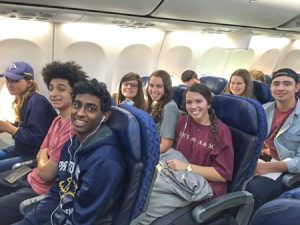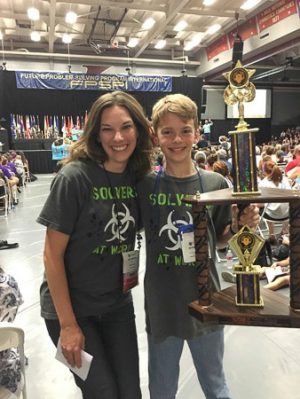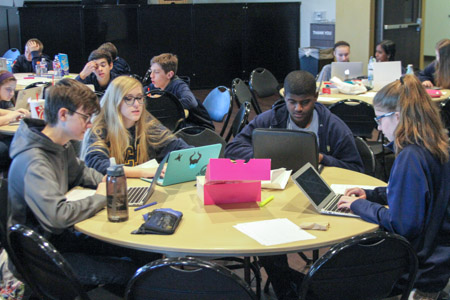Reading the future scene aloud, highlighter in hand, thoughts rush to your head. You thoughtfully gnaw on a donut, pondering the economic implications of identity theft, the topic of today’s competition. Your teammate offers a suggestion, and you both burst into laughter at its implications. Then, the pressure builds, and things get serious.
As many students today are taught what to think, Future Problem Solvers (FPS) students are instead taught how to think through the six-step FPS process.
FPS is already underway for the year with the first in-house competition set for Tuesday, Sept. 26. Students will gather in the SLC to make their initial proposals to address the issue of the spread of infectious diseases, the first area of focus for this year’s competition season.
HOW DOES IT WORK?
Receiving a topic about two months before the competition, students begin thoughtful research about the details of the topic. Students not only research potential issues that could stem from the topic, but pre-existing solutions to those issues. By being aware of current technologies and programs, it allows the student to make more accurate decisions about what solutions could be applicable 30 years down the road.
The day of an FPS competition, students sit with their teams (comprised of four students) and receive a future scene. They have two hours in which to solve it. The scenario provides a narrative of a future situation, in which several problems exist along with a “charge” to address.
Students must brainstorm and infer 16 potential problems that could stem from the future scene. Developing a focused question, students choose a focal, underlying problem that addresses the charge. Students then create 16 possible solutions, encompassing a variety of different categories, such as technology, education or psychological health. Filtering their top solutions through five criteria, the students arrive at their best solution. Finally, students expand upon their solution, writing a proposal to potential clients regarding their plan of action.
Mr. Tim Hurson, a founder of Think Intellectual Capital, a firm that “provides global corporations with training, facilitation and consultation in productive thinking,” champions the FPS process. When interacting with corporations, he utilizes a model of six steps to teach employees how to think creatively and powerfully. Future Problem Solvers parallels this model with six similar steps, forming a process that engages students in critical thinking, not just memorization.

Members of FPS travel to the International competition in Wisconsin. The team brought home two Championships and many other awards.
WHAT ARE THE STEPS?
To better understand the process, here are the steps using the sample topic of identity theft:
Step 1 Brainstorm challenges in a given scenario.
Victims of identity theft in 2037 don’t properly respond to an information breach, amplifying negative effects across the Metroplex.
Step 2 Identify the underlying issue.
Because identity theft victims suffer from the repercussion of this crime when they fail to address the issue, how can we improve user response so that any negative effects in the Metroplex are minimized in 2037 and beyond?
Step 3 Brainstorm solutions.
Local app developers will collaborate with institutions from which information is stolen, creating a system called “Breach Alert.” This app immediately notifies users of possible security breaches and theft of information and provides steps that the user can take to combat any issues in real time, thus improving response to identity theft and reducing its negative effects in 2037 and beyond.
Step 4 Generate criteria questions.
Because identity theft is extremely prevalent in the Metroplex, which solution is the most far-reaching, allowing it to be implemented in as broad an area as possible?
Step 5 Use criteria questions to determine the best solution.
“Breach Alert” most adequately fulfills each criteria, thus it is the best solution.
Step 6 Develop an action plan to implement the best solution in the scenario.
People across the Metroplex have fallen prey to the heinous crime of identity theft and fail to adequately combat it, causing numerous economic issues. However, “Breach Alert” allows users to immediately find out if their information is compromised and take steps to address such crime. This app can be used by anyone with a smartphone, tablet or computer at little or no cost, and thus is the most far-reaching. As such, implementation of “Breach Alert” will reduce the negative effects of identity theft in 2037 and beyond.
Not only do these steps teach students how to begin the journey of creative thinking, they mirror success in the real world. Many corporations invite instructors, such as Mr. Hurson, to teach their employees how to think. Thus, by already cultivating these skills, FPS students can set themselves apart in this way.
WHERE DO THEY GET THE TOPICS?
In addition to learning how to think creatively, preparation based on the specific topics is key, as senior division team—Seniors Natania Christopher, Lexi Colan, Jordi Gile and Avery Powell—will attest. They credit their State Championship last Spring to thoughtful research and brainstorming. By researching common patterns in identity theft and being knowledgeable of current deterrents, the team could create a truly futuristic solution to this problem.
FPS topics are drawn from the forefront of science, technology, politics and society. In the early 2000s, nanotechnology was a foreign topic to students and teachers alike; now it’s a field of study. In the 1990s, artificial intelligence seemed to be a far-fetched topic, but many aspects are coming to fruition. This year, the qualifying topic was identity theft, which, as technology advances, is becoming a more prevalent issue. By utilizing cutting edge topics, FPS encourages thoughtful research and thorough understanding of previously foreign topics. Its method of cross-curricular thinking, exposes students to a variety of fields of study.
WHAT’S THE BENEFIT?
“I teach students how to think, not what to think. If you want them to think creatively and become innovators, you must teach them a process they can practice. We need to cultivate an atmosphere of teaching kids how to think and then communicate those thoughts,” said FPS Program Director Mrs. Shannon Lichty.
Mrs. Lichty, English teacher and enthusiastic Future Problem Solving coach, has been teaching students the FPS process for nearly 25 years. After six years of doing so in Oregon, she started the FPS program here, which she has continued for the past eighteen years.
Mrs. Trudy Reed, the Seventh and Eighth grade FPS instructor, said, “FPS is an avenue for students to have practice in thinking creatively about various topics using alternative future scenarios. This will help them be successful in adapting, adjusting and developing a plan of success that is applicable in any of the unknowable future situations they might face on their own. This process coupled with the Kingdom education received at PCA allows them to apply Biblical principles in the scenarios to impact their homes, churches and communities for Christ.”
Dr. Paul Torrence, the founder of FPS, formed this idea into a fun, workable and competitive model that students can use to learn how to think faster and better. This mastery is beneficial outside of the competition room as well.
Lisa Quintana, a former FPS student who went on to compete at the international level several times, uses the skills she learned from FPS every day in her job at Dr Pepper. She was the coach of the Sixth grade team which advanced to internationals this past summer. Many FPS alumni have shared experiences of how the fast-paced, teamwork-based program helped them in college, careers and collaborations with other people.

Seventh grade student James Jordan brings home first place in the CMPS competition. His coach, Mrs. Lisa Qunitana, was an International FPS quzlifier when she was a student.
The value of the Future Problem Solving process goes far beyond a mere competition. It teaches students how to connect with others and think critically, skills that are of utmost importance as what was once the future quickly becomes present reality.
Future Problem Solvers is a multi-faceted program. Not only can students collaborate in teams or as individuals in the competition, they can also compete in scenario writing competitions, presentation of action plan performances and community improvement projects.
May graduate and class Valedictorian Josh Anil, who was a two-time State Champion and an International Champion, participated in the scenario writing competition. He said, “Scenario writing has not only buttressed my creative thinking skills, but also my writing skills. Developmentally, I believe it was an important factor in my application and acceptance into Rice.”
WINNING IS NICE, TOO
Last school year saw the school have remarkable success at the State Bowl. Jordi said, “Finding out that we won and were advancing to Internationals was such a crazy feeling. I have been in FPS since Sixth grade, so this was such an accomplishment.” Her teammate Avery said, “It was such an incredible feeling when they announced we got first place because only one other PCA team had done that in history. We were speechless and couldn’t believe that we actually qualified for Internationals.”
At the FPS International Competition held this summer at the University of Wisconsin-La Crosse, Senior Avery Rudd won the Championship in the MAGIC Competition and Seventh grade student James Jordan won the Championship in the CMPS Competition. Josh Anil, Class of 2017, and Sophomore Paloma Diaz-Minshew finished second in Scenario Writing. Freshman Anna Murray and Junior Karen Sculley finished second in Scenario Performance. Sophomore Carson Ruley finished second in MAGIC and the team of Eighth grade students Kori Brown, Ishawnia Christopher and Brianna Devadoss and Seventh grade students Ila Caron, Ronia Christopher and Joanna Anil finished fourth in Presentation of Action Plan.

State Champion FPS members celebrate qualifying for Internationals.



